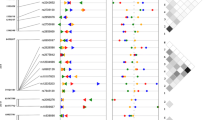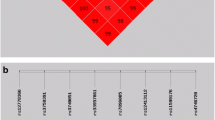Abstract
Life span is a complex and multifactorial trait, which is shaped by genetic, epigenetic, environmental, and stochastic factors. The possibility that highly hypervariable short tandem repeats (STRs) associated with longevity has been largely explored by comparing the genotypic pools of long lived and younger individuals, but results so far have been contradictory. In view of these contradictory findings, the present study aims to investigate whether HUMTHO1 and HUMCSF1PO STRs, previously associated with longevity, exert a role as a modulator of life expectancy, as well as to assess the extent to which other autosomal STR markers are associated with human longevity in population from northern Spain. To that end, 21 autosomal microsatellite markers have been studied in 304 nonagenarian individuals (more than 90 years old) and 516 younger controls of European descent. Our results do not confirm the association found in previous studies between longevity and THO1 and CSF1PO loci. However, significant association between longevity and autosomal STR markers D12S391, D22S1045, and DS441 was observed. Even more, when we compared allelic frequency distribution of the 21 STR markers between cases and controls, we found that 6 out of the 21 STRs studied showed different allelic frequencies, thus suggesting that the genomic portrait of the human longevity is far complex and probably shaped by a high number of genomic loci.
Similar content being viewed by others
References
Aznar JM et al (2014) I-DNASE21 system: development and SWGDAM validation of a new STR 21-plex reaction. Forensic Sci Int Genet 8:10–19. doi:10.1016/j.fsigen.2013.06.014
Bathum L, Andersen-Ranberg K, Boldsen J, Brosen K, Jeune B (1998) Genotypes for the cytochrome P450 enzymes CYP2D6 and CYP2C19 in human longevity. Role of CYP2D6 and CYP2C19 in longevity. Eur J Clin Pharmacol 54:427–430
Bladbjerg EM, Andersen-Ranberg K, de Maat MP, Kristensen SR, Jeune B, Gram J et al (1999) Longevity is independent of common variations in genes associated with cardiovascular risk. Thromb Haemost 82:1100–1105, doi:99091100
Bonifer C, Hume DA (2008) The transcriptional regulation of the colony-stimulating factor 1 receptor (CSF1R) gene during hematopoiesis. Front Biosci 13:549–560, doi:2700
Broer L et al (2015) GWAS of longevity in CHARGE consortium confirms APOE and FOXO3 candidacy. The Journals of Gerontology, Series A: Biological Sciences and Medical Sciences 70:110–118. doi:10.1093/gerona/glu166
Brooks-Wilson AR (2013) Genetics of healthy aging and longevity. Hum Genet 132:1323–1338. doi:10.1007/s00439-013-1342-z
De Benedictis G et al (1997) DNA multiallelic systems reveal gene/longevity associations not detected by diallelic systems. The APOB locus Hum Genet 99:312–318
De Benedictis G et al (1998) Gene/longevity association studies at four autosomal loci (REN, THO, PARP, SOD2). Eur J Hum Genet 6:534–541. doi:10.1038/sj.ejhg.5200222
Deelen J et al (2014) Genome-wide association meta-analysis of human longevity identifies a novel locus conferring survival beyond 90 years of age. Hum Mol Genet 23:4420–4432. doi:10.1093/hmg/ddu139
Dozmorov MG et al (2009) Unique patterns of molecular profiling between human prostate cancer LNCaP and PC-3 cells. Prostate 69:1077–1090. doi:10.1002/pros.20960
Erdemir T, Bilican B, Oncel D, Goding CR, Yavuzer U (2002) DNA damage-dependent interaction of the nuclear matrix protein C1D with translin-associated factor X (TRAX). J Cell Sci 115:207–216
Excoffier L, Lischer HE (2010) Arlequin suite ver 3.5: a new series of programs to perform population genetics analyses under Linux and Windows. Mol Ecol Resour 10:564–567. doi:10.1111/j.1755-0998.2010.02847.x
Gemayel R, Vinces MD, Legendre M, Verstrepen KJ (2010) Variable tandem repeats accelerate evolution of coding and regulatory sequences. Annu Rev Genet 44:445–477. doi:10.1146/annurev-genet-072610-155046
Guo J, Chen S, Huang C, Chen L, Studholme DJ, Zhao S et al (2004) MANSC: a seven-cysteine-containing domain present in animal membrane and extracellular proteins. Trends Biochem Sci 29:172–174. doi:10.1016/j.tibs.2004.02.007
Haferlach C et al (2011) CDKN1B, encoding the cyclin-dependent kinase inhibitor 1B (p27), is located in the minimally deleted region of 12p abnormalities in myeloid malignancies and its low expression is a favorable prognostic marker in acute myeloid leukemia. Haematologica 96:829–836. doi:10.3324/haematol.2010.035584
He YH, Lu X, Bi MX, Yang LQ, Xu LY, Kong QP (2014) The reduction of vascular disease risk mutations contributes to longevity in the Chinese population. Meta Gene 2:761–768. doi:10.1016/j.mgene.2014.09.010
Hering S, Muller E (2001) New alleles and mutational events in D12S391 and D8S1132: sequence data from an eastern German population. Forensic Sci Int 124:187–191
Herskind AM, McGue M, Holm NV, Sorensen TI, Harvald B, Vaupel JW (1996) The heritability of human longevity: a population-based study of 2872 Danish twin pairs born 1870–1900. Hum Genet 97:319–323
Huckenbeck W, Scheil HG, Schmidt HD, Efremovska L, Mikerezi I (2004) Allele frequencies of D21S11, FGA, TH01, and VWA in populations of the Balkans. Hum Biol 76:943–946
Hui L, Weijian Y, Xuelian D, Qigui L (2011) Variations in short tandem repeats deduced on the basis of the number of repeats and the relationship of these variations with longevity. Age (Dordr) 33:63–68. doi:10.1007/s11357-010-9160-x
Kalinowski ST, Taper ML, Marshall TC (2007) Revising how the computer program CERVUS accommodates genotyping error increases success in paternity assignment. Mol Ecol 16(5):1099–1106
Kim S, Welsh DA, Myers L, Cherry KE, Wyckoff J, Jazwinski SM (2015) Non-coding genomic regions possessing enhancer and silencer potential are associated with healthy aging and exceptional survival. Oncotarget 6:3600–3612, doi:2877
Malek TR, Castro I (2010) Interleukin-2 receptor signaling: at the interface between tolerance and immunity. Immunity S1074-7613(10):00287–6. doi:10.1016/j.immuni.2010.08.004
McGue M, Vaupel JW, Holm N, Harvald B (1993) Longevity is moderately heritable in a sample of Danish twins born 1870–1880. J Gerontol 48:B237–B244
Menashe I, Rosenberg PS, Chen BE (2008) PGA: power calculator for case–control genetic association analyses. BMC Genet 9:36. doi:10.1186/1471-2156-9-36
Minster RL et al. (2015) Genome-wide association study and linkage analysis of the healthy aging index. J Gerontol A Biol Sci Med Sci doi:10.1093/gerona/glv006
Park S (2001) The Excel microsatellite toolkit. Trypanotolerance in west African cattle and the population genetic effects of selection. Ph.D thesis, University of Dublin, Dublin, Ireland
Riley DE, Krieger JN (2005) Short tandem repeat (STR) replacements in UTRs and introns suggest an important role for certain STRs in gene expression and disease. Gene 344:203–211. doi:10.1016/j.gene.2004.09.034
Schachter F, Faure-Delanef L, Guenot F, Rouger H, Froguel P, Lesueur-Ginot L et al (1994) Genetic associations with human longevity at the APOE and ACE loci. Nat Genet 6:29–32. doi:10.1038/ng0194-29
Slagboom PE et al (2011) Genomics of human longevity. Philos Trans R Soc Lond B Biol Sci 366:35–42. doi:10.1098/rstb.2010.0284
Tan Q et al (2001a) Measuring the genetic influence in modulating the human life span: gene-environment interaction and the sex-specific genetic effect. Biogerontology 2:141–153
Tan Q et al (2001b) Variations of cardiovascular disease associated genes exhibit sex-dependent influence on human longevity. Exp Gerontol 36:1303–1315, doi:S0531-5565(01)00102-4
Tan Q et al (2002) The influences on human longevity by HUMTHO1.STR polymorphism (tyrosine hydroxylase gene). A relative risk approach. Mech Ageing Dev 123:1403–1410, doi:S0047637402000817
Toth G, Gaspari Z, Jurka J (2000) Microsatellites in different eukaryotic genomes: survey and analysis. Genome Res 10:967–981
vB Hjelmborg J et al (2006) Genetic influence on human lifespan and longevity. Hum Genet 119:312–321. doi:10.1007/s00439-006-0144-y
von Wurmb-Schwark N, Caliebe A, Schwark T, Kleindorp R, Poetsch M, Schreiber S et al (2011) Association of TH01 with human longevity revisited. Eur J Hum Genet 19:924–927. doi:10.1038/ejhg.2011.43, ejhg201143
Wu W et al (2006) Advertisement mutational analysis of candidate genes at 12P12-13 in prostate carcinoma. Proc Amer Assoc Cancer Res 47
Yashin AI et al (1999) Genes, demography, and life span: the contribution of demographic data in genetic studies on aging and longevity. Am J Hum Genet 65:1178–1193. doi:10.1086/302572
Zheng L, Sharma R, Gaskin F, Fu SM, Ju ST (2007) A novel role of IL-2 in organ-specific autoimmune inflammation beyond regulatory T cell checkpoint: both IL-2 knockout and Fas mutation prolong lifespan of Scurfy mice but by different mechanisms. J Immunol 179:8035–8041, doi:179/12/8035
Acknowledgements
This work has been funded through the call Consolidation of Research Groups Basque Government (IT833-13). The authors would like to acknowledge and thank all the donors who participated in this study and the staff of centers that have collaborated in the project for their help in collecting samples. The authors are grateful to Maite Alvarez, Ph.D., for her technical and human support provided by the DNA Bank Service (SGIker) of the University of the Basque Country (UPV/EHU).
Conflict of interest
The authors declare that they have no conflict of interest.
Author information
Authors and Affiliations
Corresponding author
Electronic supplementary material
Below is the link to the electronic supplementary material.
Table S1
Statistical power analysis of the study (DOC 44 kb)
Table S2
Allele frequency distribution for 21 autosomal STRs in nonagenarians (DOC 229 kb)
Table S3
Allele frequency distribution for 21 autosomal STRs in controls (DOC 250 kb)
Table S4
Comparison of allele frequencies using the chi-square test (DOC 70 kb)
Table S5
Genotypic frequencies of the HUMTHO1 STR across three different European populations (DOC 77 kb)
About this article
Cite this article
Bediaga, N.G., Aznar, J.M., Elcoroaristizabal, X. et al. Associations between STR autosomal markers and longevity. AGE 37, 95 (2015). https://doi.org/10.1007/s11357-015-9818-5
Received:
Accepted:
Published:
DOI: https://doi.org/10.1007/s11357-015-9818-5




